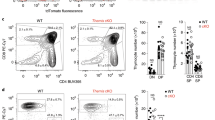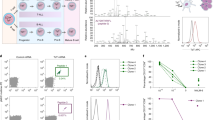Abstract
The T3/T-cell receptor complex on the surface of human thymus-derived lymphocytes consists of four glycoproteins: the α-chain of relative molecular mass (Mr) 40,000–50,000 (40–50K), the β-chain (37–45K); the γ-chain (25K) and the δ-chain (20K)1–3. The T3 α- and β-chains have been identified as clonotypic T-cell receptors3–7, but functionally the T3/T-cell receptor chains seem to form a single complex: monoclonal antibodies directed at the 20K T3 components are mitogenic for normal human T lymphocytes8,9 and, at higher concentrations, anti-clonotypic and anti-20K reagents block T-cell function4,10. Recently, Zanders et al.11 showed that incubation of human T-helper clones with high concentrations of antigen abolishes antigen-specific proliferation and induces disappearance of T3 from the cell surface. Thus, the T3/T-cell receptor complex consists of two variable subunits, the T3 α- and β-chains, which interact with antigen and the monomorphic 20K/25K T3 chains. Recently, the existence of a fifth polypeptide chain, the unglycosylated T3 ε-chain, has been postulated12,13. Here we confirm that a 20K ε-chain does exist. The T3 ε-chain differs from the T3 δ-chain in primary structure as judged by N-terminal amino acid sequencing, peptide mapping and immuno-blotting with anti-T3-δ and anti-T3-ε antibodies. Treatment with endoglycosidase F revealed two nonglycosylated T3 δ polypeptide backbone chains (16K and 14K) with identical amino termini. Together with previous pulse-chase experiments2 this observation suggests that the 14K T3 polypeptide is derived from the 16K T3 precursor by proteolytic processing near the C-terminus of the molecule.
This is a preview of subscription content, access via your institution
Access options
Subscribe to this journal
Receive 51 print issues and online access
$199.00 per year
only $3.90 per issue
Buy this article
- Purchase on Springer Link
- Instant access to full article PDF
Prices may be subject to local taxes which are calculated during checkout
Similar content being viewed by others
References
Borst, J., Prendiville, M. A. & Terhorst, C. J. Immun. 128, 1560–1565 (1982).
Borst, J., Alexander, S., Elder, J. & Terhorst, C. J. biol. Chem. 258, 5135–5141 (1983).
Reinherz, E. L. et al. Proc. natn. Acad. Sci. U.S.A. 80, 4104–4110 (1983).
Reinherz, E. L., Meuer, S. C. & Schlossman, S. F. Immun. Rev. 74, 83–112 (1983).
Allison, J. P., McIntyre, B. W. & Bloch, D. J. Immun. 129, 2293–2299 (1982).
Haskins, K. et al. J. exp. Med. 157, 1149–1157 (1983).
Oettgen, H., Kappler, J., Tax, W. & Terhorst, C. J. biol. Chem. 259, 12039–12048 (1984).
van Wauwe, de Mey, J. R. & Goossens, J. G. J. Immun. 124, 2708–2714 (1980).
Tax, W. J. M., Willems, H. W., Reekers, P. P. M., Capel, P. J. A. & Koene, R. A. P. Nature 304, 445–447 (1983).
Spits, H., Borst, J., Terhorst, C. & de Vries, J. E. J. Immun. 129, 1563–1569 (1982).
Zanders, E. D., Lamb, J. R., Feldmann, M., Green, N. & Beverley, P. C. L. Nature 303, 625–627 (1983).
Borst, J., Prendiville, M. A. & Terhorst, C. Eur. J. Immun. 13, 576–580 (1983).
Kanellopoulos, J. M., Wigglesowrth, N. M., Owen, M. J. & Crumpton, M. J. EMBO J. 2, 1807–1814 (1983).
Van den Elsen, P. et al. Nature 212, 413–418 (1984).
Kabat, E. A., Wu, T. T., Bilofsky, H., Reid-Miller, M. & Perry, H. Sequences of Proteins of Immunological Interest (U. S. Department of Health, Education and Welfare, 1983).
Yanagi, Y. et al. Nature 308, 145–148 (1984).
Hedrick, S. M., Cohen, D. I., Nielsen, E. A. & Davis, M. M. Nature 308, 149–153 (1984).
Hedrick, S. M., Nielsen, E. A., Kavaler, J., Cohen, D. I. & Davis, M. M. Nature 308, 153–157 (1984).
Saito, H. et al. Nature 309, 757–762 (1984).
Snow, P., Keizer, G., Coligan, J. E. & Terhorst, C. J. Immun. 133, 2058–2066 (1984).
Williams, A. F. & Gagnon, J. Science 216, 696–702 (1982).
Oettgen, H. C., Terhorst, C., Cantley, L. C. & Rosoff, P. Cell (submitted).
Terhorst, C. et al. Cell 23, 771–780 (1981).
Terhorst, C., LeClair, K., Ma, A. & Slayter, H. Molec. Immun. 18, 520–529 (1980).
Schneider, C., Newman, R. A., Asser, U., Sutherland, D. R. & Greaves, M. F. J. biol. Chem. 257, 10766–10772 (1982).
Hunkapiller, M. W., Lujan, E., Ostrander, F. & Hood, L. E. Meth. Enzym. 91, 227–231 (1983).
Adair, S. Analyt. Biochem. 126, 299–306 (1982).
Coligan, J. E., Gates, F. T., Kimball, E. S. & Maloy, W. L. Meth. Enzym. 91, 413–417 (1983).
Towbin, J., Staehelin, T. & Gordon, J. Biochemistry 76, 4350–4355 (1979).
Green, N. et al. Cell 28, 477–487 (1982).
Author information
Authors and Affiliations
Rights and permissions
About this article
Cite this article
Borst, J., Coligan, J., Oettgen, H. et al. The δ- and ε-chains of the human T3/T-cell receptor complex are distinct polypeptides. Nature 312, 455–458 (1984). https://doi.org/10.1038/312455a0
Received:
Accepted:
Issue Date:
DOI: https://doi.org/10.1038/312455a0
This article is cited by
-
Who wins the combat, CAR or TCR?
Leukemia (2023)
-
Recent insights of T cell receptor-mediated signaling pathways for T cell activation and development
Experimental & Molecular Medicine (2020)
-
DNase hypersensitivity and methylation of the humanCD3G andD genes during T-cell development
Immunogenetics (1990)
-
A T-cell receptor γ/CD3 complex found on cloned functional lymphocytes
Nature (1987)
-
Phenotypic and genotypic characteristics of the human prothymocyte
Immunologic Research (1987)
Comments
By submitting a comment you agree to abide by our Terms and Community Guidelines. If you find something abusive or that does not comply with our terms or guidelines please flag it as inappropriate.



